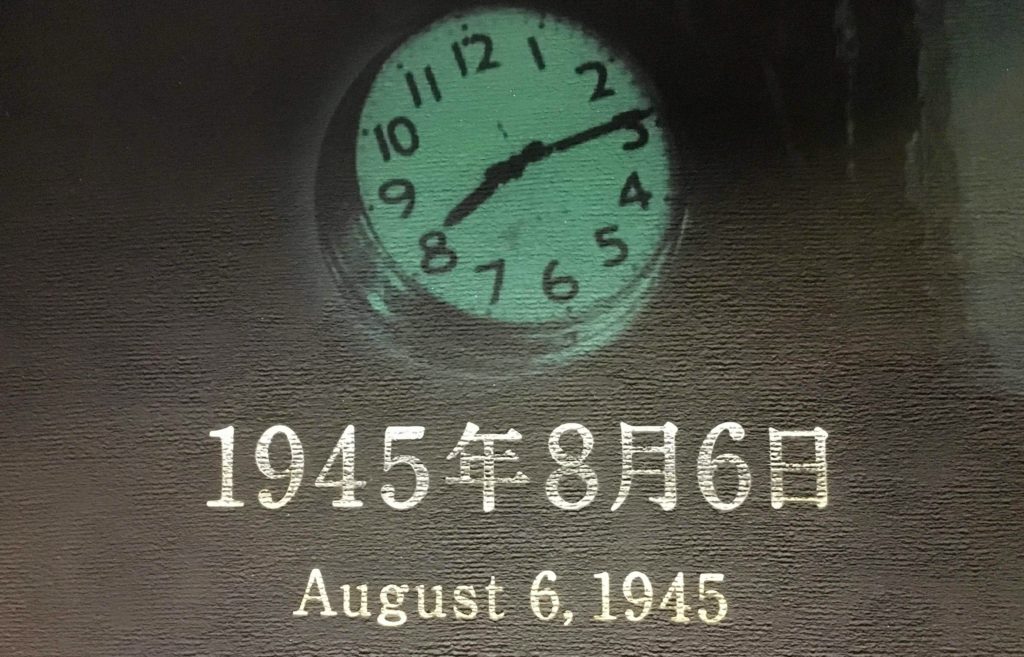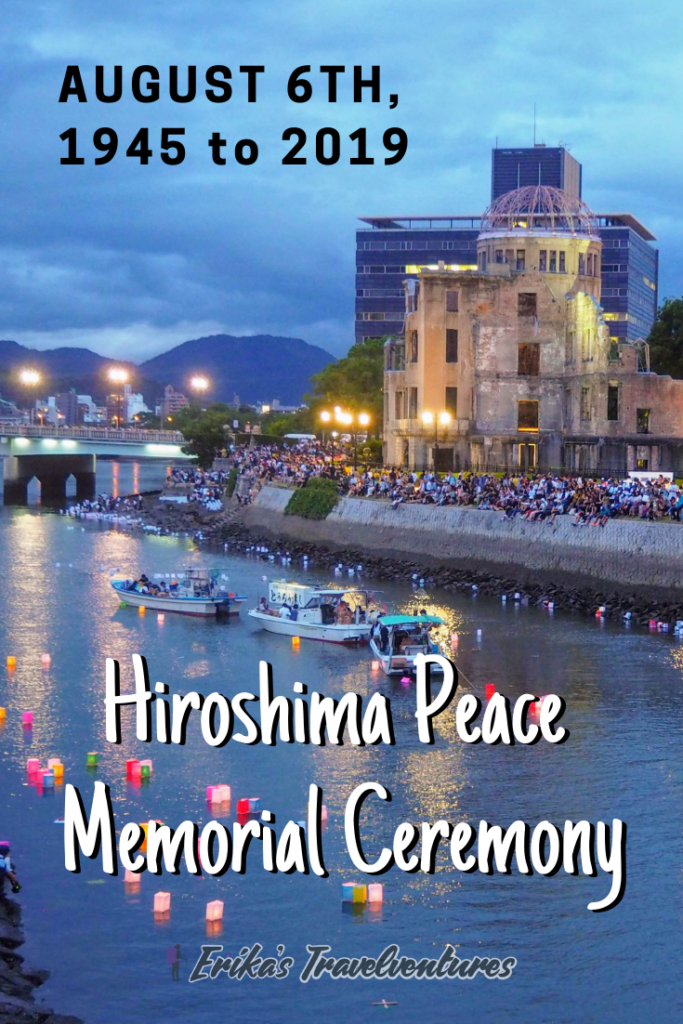8:15 a.m., August 6th, 1945.
The moment the earth stood still for the 350,000 residents of Hiroshima, Japan.
During World War II, an atomic bomb, nicknamed “Little Boy,” was detonated 600 meters over the city by American troops. It killed up to 80,000 people in one instant and devastated the city.
The state that Hiroshima and its surviving citizens were left in after the mushroom cloud dispersed is something that thousands of people would never forget. Fast forward several decades. The city of Hiroshima holds the Hiroshima Peace Memorial Ceremony every August 6th, the remember the events and vow to never let nuclear weapons strike any city again.

Every year on August 6th, the Hiroshima Peace Memorial Ceremony is held Hiroshima’s central Peace Memorial Park. The ceremony is open to the public, and the main stage is located in front of the Hiroshima Victims Memorial Cenotaph.
The Hiroshima Peace Memorial Ceremony starts at 8 a.m on August 6th, and in the evening, a lantern-floating ceremony takes place between 6 p.m. to 9 p.m.
I visited Hiroshima for the Peace Memorial Ceremony on August 6th, 2019, on the 74th anniversary of the atomic bomb dropping over the city.

Hiroshima Peace Memorial Ceremony, August 6th, 2019
I entered Hiroshima Peace Memorial Park from the Motoyasu Bridge, which is located close to the Atomic Bomb Dome. No clear signs pointed me to where the ceremony would take place, but I followed the crowd of hundreds of school children towards the south side of the park.
The Japanese equivalent of Boy Scouts were handing out ceremony program booklets to everyone along the park paths. Others volunteers were handing out small bundles of flowers, that we could give as an offering to the victims after the ceremony.
Inside the ceremony program booklets were a schedule of events, a map of the park, and Japanese and English versions of the speeches and songs that would take place. There was also a small piece of origami and instructions on how to fold a paper crane.

On the south side of the Hiroshima Victims Memorial Cenotaph were several rows of chairs that were roped off, for use by official visitors as well as school children from Hiroshima schools.
A collective choir, made up of singers from Hiroshima’s Chorus Association, Boys and Girls choirs, Hiroshima University’s Chorus, stood behind the stage.

Around the cenotaph were rings of flowers dedicated to the victims. There were also several rows on either side where more flowers could be placed.

At 8:00 a.m, the program began, with addresses made by a member of the Hiroshima City Council, as well the Mayor of Hiroshima.
Both addresses stressed that Hiroshima’s history and suffering sets an example for why leaders around the world should strive towards nuclear disarmament. They called on Japan’s government and the government of countries around the world to sign and ratify the Treaty on the Prohibition of Nuclear Weapons (TPNW).
“Around the world today, we see self-centered nationalism in ascendance, tensions heightened by international exclusivity and rivalry, with nuclear disarmament at a standstill … I urge Japan’s leaders to manifest the pacifism of the Japanese Constitution by displaying leadership in taking the next step towards a world free from nuclear weapons.”
– excerpt from the “Peace Declaration”, by Matsui Kazumi, the Mayor of Hiroshima, August 6th, 2019

At 8:15, the exact time that the atomic bomb detonated in 1945, the peace bell rang and a moment of silence was observed. 74 years ago at that exact moment, Hiroshima was reduced to rubble and changed forever. It was a powerful, somber silence.

Two 6th graders, students at Hiroshima elementary schools, read a “Commitment to Peace.”
“We, the children of Hiroshima, love our city. Her slow-running rivers and natural beauty, the voices of the community, welcoming us back from school. Citizens that are ever resilient and hopeful. Hiroshima is full of these precious things and more.”
Their voices spoke in unison, with slow, deliberate words. The speech then took a turn for the gruesome.
“August 6th, 1945. On that day, and the days to come, hellish sights so horrific they could not be unseen unfolded; the rivers run red with blood, the mountains of debris, the people stripped of their skin, piles of corpses.”
Before coming to Hiroshima, I wondered whether school children in Japan learned a PG version of the atomic bombing in Hiroshima and its horrific aftereffects. Turns out there are no filters for children, in either the memorial or the Hiroshima Peace Memorial Museum.

Shinzo Abe, the former prime minister of Japan, also made an appearance and speech. He gave his in condolences to the victims of Hiroshima, and to those still suffering today from the aftereffects of that day. He preached that Japan will continue its efforts to strive towards a world free of nuclear weapons.
See his full speech here.
During the pauses between his sentences, there were voices of protesters that echoed around the Peace Memorial Park. They were somewhere unseen and too far away to be understood.
Hiroshima Peace Memorial Closing Ceremony
At the end of the program, the Hiroshima Peace Song was sung by the members of the combined choir. The lyrics and notes to sing along were included in the program booklet.
After the ceremony, hundreds of people lined up in front of the cenotaph to say their prayers and leave flowers for the victims.

Visiting the Hiroshima Peace Memorial Museum
I made my way to the Hiroshima Peace Memorial Museum, where already a massive line of people was forming.
Visiting the museum was an incredibly moving experience. The exhibits highlighted the suffering and loss experienced by people who survived the initial bombing of Hiroshima. Artifacts such as burned clothing, a corroded tricycle, and letters and diaries of victims are preserved here. Art pieces display what survivors saw on August 6th, 1945: burning bodies, rivers full of the dead – memories engrained in their minds forever.
The museum is a disturbing reminder of the horrors of war, and it should not be missed during your Hiroshima itinerary.

Visiting The Children’s Memorial and Senbazuru
Inside of the program booklet that each visitor received as part of the Peace Memorial Ceremony was a small piece of origami and instructions on how to fold a paper crane. The paper cranes folded by visitors were collected at specific locations around the park, to be made into senbazuru, or thousand paper crane mobiles.
They were dedicated to the Children’s Peace Monument in the Peace Memorial Park.

The famous story of Sadako and the Thousand Paper Cranes was the catalyst that resulted in the Children’s Memorial being built, and the senbazuru, or a thousand paper cranes, becoming a symbol of peace and hope.
Sadako fell victim to the atomic bomb, 10 years after it detonated, when she developed leukemia from radiation poisoning. She spent her last days at the hospital trying to fold 1000 cranes, because making a senbazuru meant you could make a wish that would come true.
She died having only folded 644. The small cranes she folded are on display at the Hiroshima Peace Memorial Museum.

The Hiroshima Peace Memorial Ceremony, Lantern Floating
On the evening of the August 6th, Hiroshima Peace Memorial Ceremony, a beautiful lantern floating ceremony took place. In the river between the park and the Atomic Bomb Dome, people could release their lanterns into the water.
All throughout the day, visitors could purchase paper to make a lantern for 600 yen. They were asked to write a wish for world peace upon the paper, which would be later crafted into a lantern and floated down the river with a candle inside of it. The river was beautiful in the evening when it was filled with these lanterns.
At the base of the Atomic Bomb Dome were also wax lanterns made by Hiroshima children, wishing for world peace. Many of them had drawings of Pokemon – also messengers of peace?


If you plan on visiting Japan in August, I recommend trying to visit Hiroshima on August 6th for the Hiroshima Peace Memorial Ceremony and other events. Being in the city on the anniversary of the bombing is a powerful experience that brings you closer to the horrific events that happened on August 6th, 1945.
If you want to immerse yourself in the dark history of the city, but also see how the city has healed, visit Hiroshima during the August 6th Hiroshima Peace Memorial Ceremony.
Heading to Hiroshima? Pin this Post!







